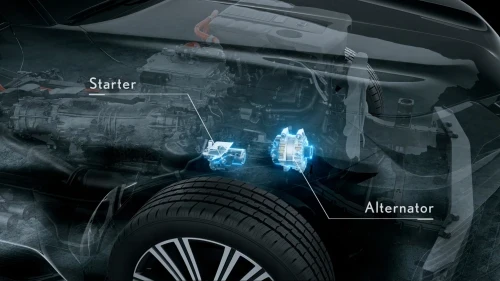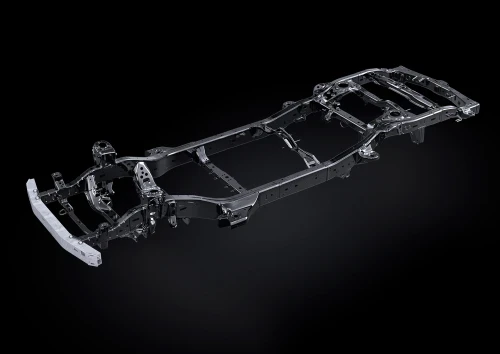Lexus is bringing new enhancements to the LX and introducing the LX 700h, featuring the brand’s newly developed hybrid system. A phased rollout across various regions is scheduled to begin in late 2024.

For the LX 700h, Lexus developed a new parallel hybrid system that prioritizes preserving the reliability, durability, and off-road performance that the LX series has cultivated over generations, even amidst the shift to electrification. By utilizing motor torque to achieve the signature Lexus driving experience, annual CO2 emissions across all global vehicles will be significantly reduced, further improving environmental performance.
Lexus has further refined its distinctive Lexus Driving Signature by enhancing the core fundamentals, including the engine model. The engaging driving dialogue that reacts instantly to driver inputs has been further refined while the vehicle has been upgraded with the latest Lexus Safety System + (LSS+) for enhanced safety and peace of mind.
Lexus engineers adopted a parallel hybrid system that integrates a motor generator (MG) with a clutch positioned between the 3.5L V6 twin-turbo engine and a 10-speed automatic transmission. This configuration maintains key features such as full-time 4WD, a Lo-range transfer case, and a torque converter-equipped automatic transmission, ensuring that the combined high output and torque from both the engine and motor are effectively transmitted to the road.

New parallel hybrid system
The hybrid control system intelligently manages the transition between engine-only and motor-only modes, optimizing performance based on driving conditions.
Additionally, this is the first Lexus system to feature both an alternator and a starter as standard components, a departure from previous Lexus parallel hybrid models. In the event of a hybrid system failure, the starter enables independent engine ignition, while the alternator powers the 12V auxiliary battery, allowing the vehicle to continue driving using only the engine.

Even in this emergency driving mode, essential features such as the transfer case’s Lo-range, ride height adjustment using Active Height Control (AHC), and Active Traction Control (A-TRAC) remain fully operational, ensuring continued off-road capability.
The vehicle features a waterproof structure that encases the hybrid main battery, located in the rear floor, within a waterproof tray divided into upper and lower sections. This design effectively prevents water ingress during deep water crossings, ensuring a fording capability of 700 mm, comparable to that of conventional engine vehicles. In the unlikely event that water does enter the tray, a water sensor positioned inside will detect it and alert the driver through a meter display.
The vehicle combines the responsive torque characteristics of the motor with a high-displacement twin-turbo engine, resulting in linear acceleration and responsive starts from low throttle operation at low speeds. At higher speeds or during full throttle, it delivers robust acceleration that leverages high torque.
In off-road conditions, the vehicle expands its capabilities beyond Hi transfer case range by adding motor-driven power to the Lo-range for the first time in a Lexus. This feature, in conjunction with the various modes of Multi-Terrain Select, enables motor-only driving in scenarios requiring precise throttle control, such as rocky paths, dirt roads, and deep snow, achieving exceptional off-road performance while ensuring ease of handling.
The vehicle is equipped with a waterproof AC inverter positioned under the center console, allowing for an external power supply of up to 1,500 W or 2,400 W, depending on the region. To enhance user convenience, power outlets have been installed at the rear of the center console and on the deck. This feature can be used for a range of activities or as an emergency power source in case of disasters.
GA-F Platform Upgrades. To accommodate the added weight and extended length of the powertrain resulting from the addition of the motor generator (MG), an exclusive cross member (Cross member Nº 3) has been added. This design optimizes the cross-section and plate thickness, achieving a low profile while ensuring a minimum ground clearance comparable to that of the engine models. Additionally, the material used for the rear engine mount has been upgraded to a more durable option to support the increased powertrain weight.

Furthermore, a new spare tire cross has been designed to reposition the spare tire in order to facilitate the installation of the hybrid main battery in the rear floor. This adjustment optimizes the mounting angle, lowering the installation position while maintaining the departure angle, thereby balancing off-road capability with serviceability.
The 12V auxiliary battery has been relocated from the engine compartment to the side of the rear deck. A dedicated metal tray and detachable battery brace have been added to enhance ease of replacement while improving body rigidity around the rear quarter area.
The new LX also adopts the rigidity enhancing radiator support modifications previously implemented in other Lexus models. These upgrades deliver a more linear response to steering inputs, while the use of patch-shaped reinforcement components helps preserve wheel articulation, enhancing steering responsiveness without compromising off-road performance.
In addition, the instrument panel reinforcement has been strengthened with added brackets to boost steering support rigidity, and existing bracket thicknesses have been optimized. These changes enhance both steering feel and overall handling stability.
The cab mount cushions used to attach the body to the frame have been completely redesigned. Strengthening the joint rigidity during frame and body twisting significantly reduces low-frequency vibrations typical of body-on-frame based vehicles. This new design maintains the frame vehicle’s inherent advantages, such as high durability and excellent road noise insulation, while delivering a responsive and more refined ride.
The valve structure of the AVS actuator has been redesigned to smoothly control dampening force when the absorber compresses rapidly, such as when driving over bumps, resulting in a smoother ride with reduced jolts. Additionally, in the Lo-transfer range, dampening force control has been improved during deceleration from extremely low speeds to a stop, minimizing unnecessary vehicle movement and enhancing both comfort and confidence when driving over rough terrain.
With the adoption of the Electro-Shiftmatic system for the hybrid model, the first for a Lexus off-road 4WD vehicle, engineers focused on enhancing ease of operation and grip during maneuvers specific to rough terrain, such as vehicle rocking, under the supervision of off-road experts. This has led to the introduction of a new, exclusive shift knob balancing a pleasant tactile feel with excellent usability. In conjunction with the Electro-Shiftmatic system, the switch for the Advanced Park (with remote function) has also been positioned in an easily visible location at the top of the center console.
Source from Green Car Congress
Disclaimer: The information set forth above is provided by greencarcongress.com independently of Alibaba.com. Alibaba.com makes no representation and warranties as to the quality and reliability of the seller and products. Alibaba.com expressly disclaims any liability for breaches pertaining to the copyright of content.




